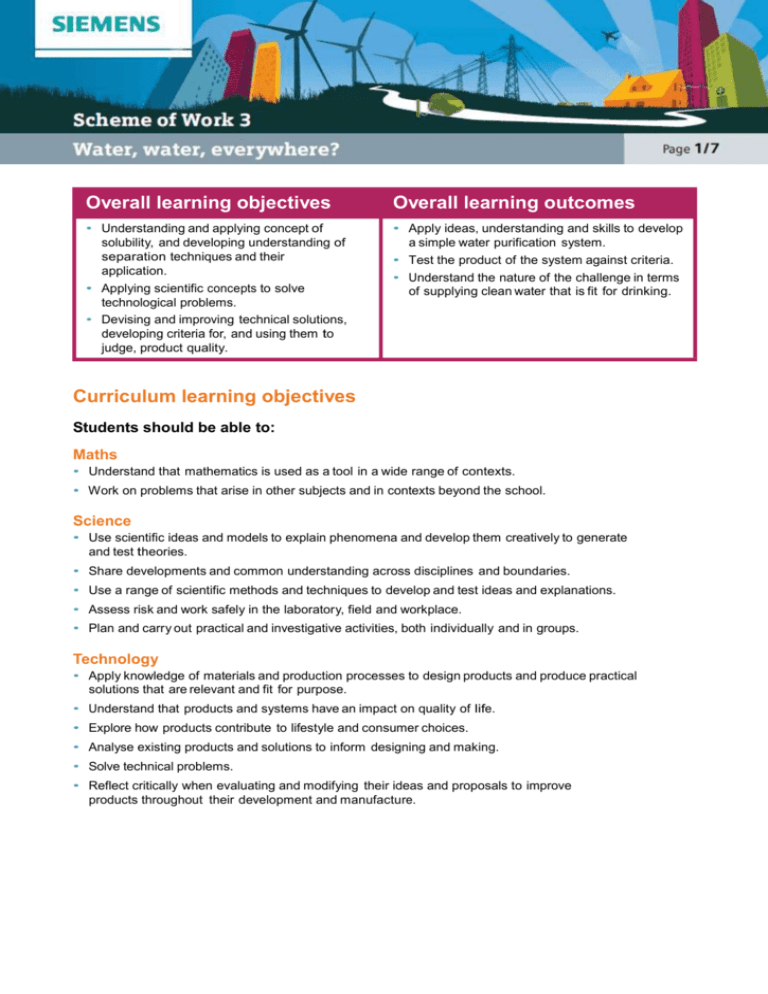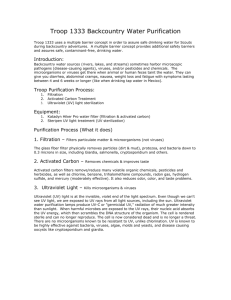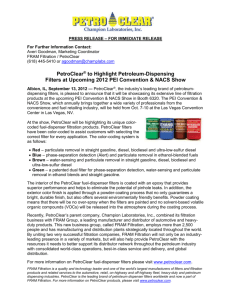Scheme of Work
advertisement

Overall learning objectives Overall learning outcomes • Understanding and applying concept of solubility, and developing understanding of separation techniques and their application. • Applying scientific concepts to solve technological problems. • Devising and improving technical solutions, developing criteria for, and using them to judge, product quality. • Apply ideas, understanding and skills to develop a simple water purification system. • Test the product of the system against criteria. • Understand the nature of the challenge in terms of supplying clean water that is fit for drinking. Curriculum learning objectives Students should be able to: Maths • Understand that mathematics is used as a tool in a wide range of contexts. • Work on problems that arise in other subjects and in contexts beyond the school. Science • Use scientific ideas and models to explain phenomena and develop them creatively to generate and test theories. • Share developments and common understanding across disciplines and boundaries. • Use a range of scientific methods and techniques to develop and test ideas and explanations. • Assess risk and work safely in the laboratory, field and workplace. • Plan and carry out practical and investigative activities, both individually and in groups. Technology • Apply knowledge of materials and production processes to design products and produce practical solutions that are relevant and fit for purpose. • Understand that products and systems have an impact on quality of life. • Explore how products contribute to lifestyle and consumer choices. • Analyse existing products and solutions to inform designing and making. • Solve technical problems. • Reflect critically when evaluating and modifying their ideas and proposals to improve products throughout their development and manufacture. Introduction The purpose of this episode is to set the scene for the topic by reminding students of the essential nature of water, what people have to do if they don’t have access to clean water and alluding to the problems that can arise from this. Learning objectives • To appreciate the importance of clean water and the problems that may arise in the absence of it. Learning activities 1. Ask students to watch the video “Waiting for Water”. 2. Ask them to work in groups and consider these questions: a) Why was it a problem for the orphanage when the pump in the water kiosk failed? b) What kind of problems might arise from using river water? c) What do you think might be included in ‘waterborne diseases’? 3. Take feedback and draw out these points: a) If there is no clean water people have to revert to other sources, such as river water. b) The River water includes a number of pollutants, some of which can cause illnesses. c) Waterborne diseases include cholera and typhoid, although the presence of contaminated water can give rise to a range of other diseases. Outcomes • Students will be able to summarise the significance of the water supply. The Challenge The purpose of this episode is to sharpen the focus on the challenge of producing clean drinking water. Learning objectives • Students will be able to explain that pollutants may be soluble or insoluble. Additional resources required • • • • Beaker Salt water Sand Gravel and silt • Students will also be able to explain how insoluble solids may be efficiently removed. Learning activities 1. Explain that there are several ways in which water may be considered unclean. Say that there may be soluble substances in it, i.e. chemicals that have dissolved. At this point you could add, salt to a beaker of water. Then say that there may by insoluble substances in it, i.e. things that won’t dissolve. These may settle out or be suspended in the water. At this point you could add some fine sand or gravel, which will settle to the bottom, and some silt, which will float around in the water and make it cloudy. 2. Ask students to work in groups and suggest ways of removing the salt, sand and silt from the water. 3. Take feedback and draw out that insoluble substances can be removed by filtration (as long as the filters are fine enough) but that soluble substances need another process, such as evaporating and condensing. Ask students what will happen to filters over a period of time. 4. Ask students to come up with a design for a constant at the other flow filtration system. This should enable water from a supply to enter at one end and leave clear of insoluble solids. It should be possible to clear the filters. Students should present their ideas as a large labelled diagram; these can be displayed and peer assessed. Outcomes • Students will have devised and explained a way of removing insoluble solids on a continuous flow basis. Investigate This episode extends the topic to studying how water can be contaminated by microorganisms and then encourages students to consider how this could be addressed. Additional resources required • Agar solution and plates • Binocular, microscope/digital microscope Learning objectives • Students are learning how to reveal the presence of microorganisms in water. • Students are considering how microorganisms can be removed, from water. Learning activities 1. Explain that as well as chemicals, pond and river water can also contain microorganisms and that in this lesson there are going to be ways used of seeing what these are like. 2. There are three activities in this next phase; it will be important to decide how this is to be organised. It could be that each is done by a different group of students and that outcomes are shared, or that students do all three. a) Growing bacteria from pond water. Students need to use student support sheet 3A Finding and growing microbes which describes the protocol for growing bacteria from pond water on agar plates. This needs to be done with care to ensure success (and safety) but should provide good evidence. b) Finding waterborne creatures. A sample of pond water should yield some interesting creatures which can be viewed by using a binocular microscope and having the water in a plastic petri dish. An alternative to the microscope is to use a digital microscope and laptop computer; the microscope will be able to capture images. c) Researching images of pond and river microorganisms that carry diseases. Findings can be set up as slides in a presentation to share with the rest of the class. 3. Ask students to share findings and establish what they have learned. Gather and display key points about the presence of microorganisms, the range of types and some of the diseases they cause. 4. Then ask students to suggest how these might be removed and draw out that filtration will work as long as the filters are fine enough. Outcomes • Students will have gathered or learned about a range of evidence to indicate that microorganisms live in pond and river water. • Students will understand that these can cause a number of diseases. Investigate and Demonstrate The purpose of this episode is for students to interrogate information about the water purification system used in the safe water kiosk featured in the video. They can use this to find out about what it will (and will not) remove as well as other data. Learning objectives • Students will extract information about the filtration system and use this to describe what the system is capable of doing. Learning activities 1. Explain that the clean water kiosk in the video was fitted with a SkyHydrant filtration system. Like all manufactured equipment this comes with information that specifies what it will and will not do. Students are going to use this to evaluate the equipment. 2. Show students a diagram of the water purification plant. a) Why is a pump needed? b) Why is the raw water tank on a tank stand? c) Why does the water not need pumping from the purification unit to the drinking water tank? d) Why store the drinking water in a tank rather than have people take it straight from the purification unit? 3. Issue students with the SkyHydrant specification sheet student support sheet 3B and the SkyHydrant fact sheet student support sheet 3C. Explain that there are a number of questions that these will help them to answer: a) What does “gravity fed” mean? b) Is this an advantage or disadvantage? c) How much water per hour can one unit filter? d) What will it remove? e) What will it not remove? f) Why are three different figures given for its weight? g) Why would it be important to test the water before installing this unit and using it to supply people with drinking water? h) What are WHO (World Health Organisation) standards? i) The filters are cleaned using a process called ‘backwash’. How do you imagine this might work? j) Madam Elizabeth and her fostered children can safely drink the water after it has been through this filtration process. What does this suggest about the water before it goes into the filtration unit? 4. Finally ask students to answer a more general question: “Does the filtration unit produce clean water?” draw out that the unit is designed to remove certain things that would make water dangerous or unpleasant to drink. Whether it makes it clean depends upon what is in it to start with. It is also worthwhile pointing out that clean doesn’t mean pure. As the sheets show, there are lots of chemicals that can be present in small amounts (and, in fact, pure water doesn’t actually taste very nice). Outcomes • Students will have extracted information from the technical specifications. • The information will have been used to support conclusions about the equipment and what it is good at doing. Compare and contrast The film clip “Thirsty Strawberries” provides a different context and then compares the demand for water in one of the most prosperous areas (Southern California) with that seen previously in Africa. Learning objectives • Students will compare and contrast the two situations with regard to the technical challenge. • Students will understand how technical solutions are re-engineered for different contexts. Learning activities 1. Explain that the students are going to see an application of the same technology (Siemens Memcor membrane filters are used in both situations) but with different challenges. 2. Show the video “Thirsty Strawberries” and then show students a picture of the filtration plant in operation in Southern California. Ask them to think about the difference in situations. 3. Ask students to share ideas and draw out key points, one in particular being, to provide a business with large quantities of water to keep it profitable and capable of supporting employees as well as providing basic drinking needs. Furthermore the African application is much cheaper and uses less complex technology. However the membrane filters at the heart of both systems are the same. Outcomes • Students will have compared and contrasted two different contexts, identified common features and how they have been applied in different ways. Demonstrate This episode is a development of a previous episode where students devise and explain a way of removing insoluble solids on a continuous flow basis. However, in this episode their understanding of what needs to be removed is now greater and they will be testing the ‘product’. Additional resources required • A beaker of dirty water • Requested materials to filter the water Learning objectives • To design and set up a water purification system. • To apply agreed tests to judge the quality of the water. Learning activities 1. Explain to students that they will be provided with water to purify and test (letter should be dirty but not dangerous). 2. Ask students to work in groups to design a filtration system that will produce water which is as clean as possible. They will need to think about what could be used to filter the water (materials may need to have been selected and requested in advance). 3. Set the test rigs up and gather water. 4. Then ask students to test the water supplies, using the agreed procedures. Outcomes • Students will have applied their ideas and understanding in a practical context to filter water. • Students will have tested the water in various ways and decided which samples have passed which tests.





